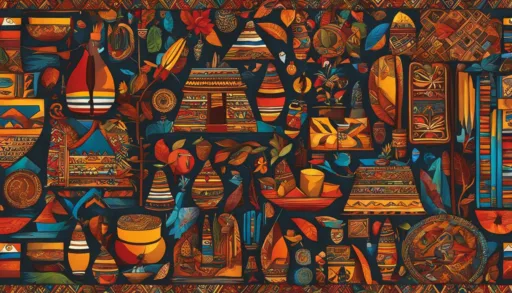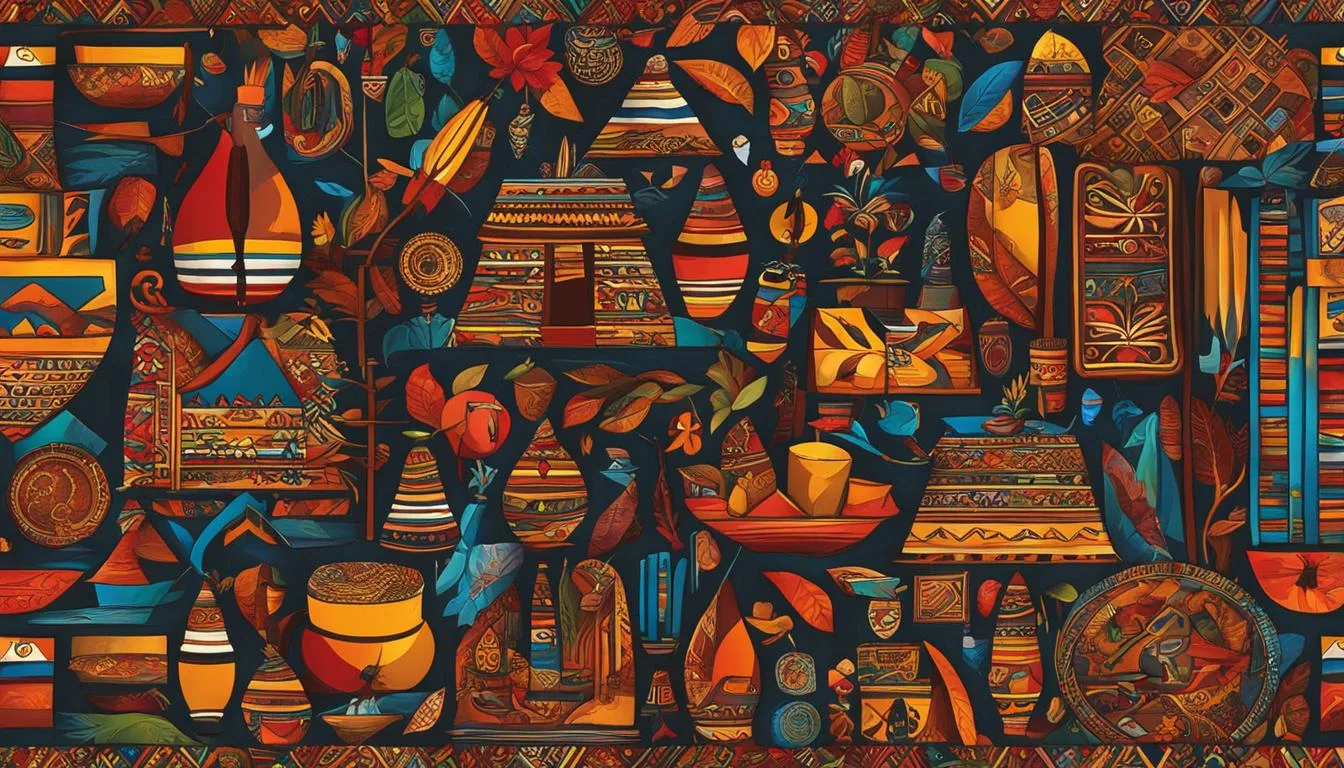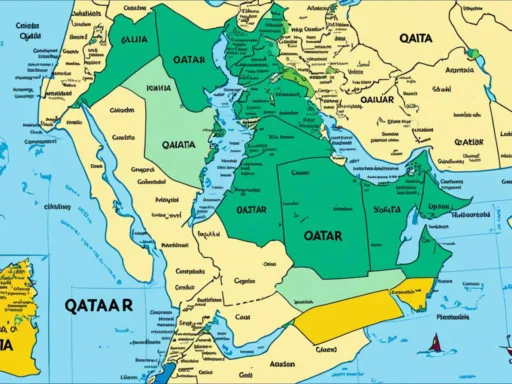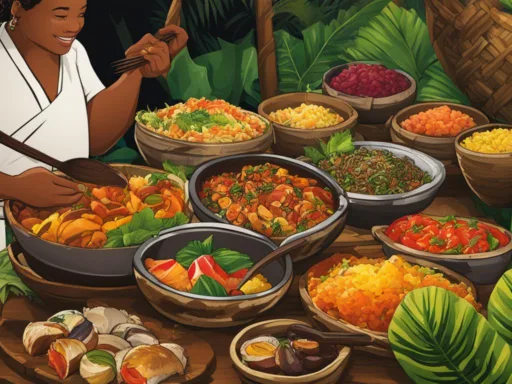Imagine a nation where thirty different languages weave through its cultural landscape—a testament to diversity and history. This is Namibia, a vibrant nation where the languages spoken span Germanic roots to indigenous Bantu branches and the unique clicks of the Khoisan tongues. Against the backdrops of red deserts and Atlantic coasts, the polyphonic chorus of languages reflects a land rich in cultural significance. As a beacon of linguistic variety, Namibia endorses English as its sole official language, setting an example of how a nation can embrace unity while celebrating its diverse heritage. The languages spoken in Namibia paint a vivid picture of its people and their stories, forming an essential code to understanding this fascinating corner of Southern Africa.
Key Takeaways
- Linguistic diversity in Namibia encompasses various language families, contributing to the nation’s cultural wealth.
- Despite English being the official language, indigenous languages retain a profound influence on Namibia’s socio-cultural dynamics.
- Oshiwambo dialects form the linguistic bedrock for nearly half of the Namibian population.
- Through language, Namibia tells a story of colonial history, independence, and a continuing journey towards unity in diversity.
- The coexistence of multiple languages in Namibia spotlights the country as a microcosm of linguistic integration with global significance.
- The country’s commitment to preserving indigenous languages underlines the importance of cultural identity in a rapidly globalizing world.
An Overview of Namibia’s Linguistic Landscape
The languages of Namibia are as varied and colorful as its famed landscapes, offering a glimpse into its heart, where communication transcends its utilitarian role to become a tapestry of heritage and identity. With a history rich in cultural cross-pollination, each language and dialect in this Southern African nation is a thread in the ever-evolving story of its people.
The Role of Language in Namibia’s Culture
In Namibia, languages are more than mere vehicles for routine exchange; they are repositories of cultural significance. The narratives, songs, and proverbs passed down through generations in indigenous tongues form the bedrock of the nation’s cultural edifice. The linguistic biodiversity in Namibia not only defines social relations but also reflects the deep-rooted traditions and soul of its communities.
Language Families Represented in Namibia
Among the Germanic offerings, we find German survivors of colonial influence and Afrikaans, the language of Namibia’s southern neighbors, seamlessly incorporated into the societal vernacular. Yet, it’s the wide array of Namibia indigenous languages that truly characterizes the nation’s dialectal wealth. The Bantu languages, spoken across multiple ethnic groups, create a soundscape rich with diversity, while the Khoisan family’s unique click consonants echo the land’s ancient heritage.
| Language Family | Languages | Areas of Influence |
|---|---|---|
| Germanic | German, Afrikaans | Throughout Namibia, with German often found in tourism, heritage sites, and Afrikaans in southern regions |
| Bantu | Oshiwambo, Herero, Kwanyama, and others | Predominantly northern and central areas, including towns and rural villages |
| Khoisan | Nama, Damara | Widespread in rural communities, with a strong presence in cultural tourism |
The influence of these languages extends far beyond conversation, decorating daily life with a myriad of Namibia dialects that demonstrate the country’s linguistic resilience and charm. As a testament to human expression, Namibia’s languages remain central to its identity, sustaining the heartbeat of a nation proudly echoing its ancestral whispers.
Namibia’s Official Language Policy
Following Namibia’s stride to independence, there was a significant shift in the linguistic narrative that would shape the nation’s identity. The decision to elect English as the only official language was not just a functional move for administrative cohesion, but also a statement of national unity and a step toward global integration. English, now at the heart of Namibia’s official languages, plays a pivotal role in the socio-economic landscape of the country.
English as the Official Language of Namibia
The choice of English as Namibia’s official language post-independence underscores a focus on inclusivity and accessibility. Primary education pays homage to the multicultural fabric of Namibian society by offering instruction in indigenous languages. However, as a testament to the forward-looking perspective that the nation holds, English becomes the medium in secondary and higher education settings. This ensures that students across Namibia can connect with the international community, and are equipped with linguistic tools vital for opportunities in a globalized world.
Historical Changes in Language Status
The evolution of language status in Namibia is a reflection of its broader history. Moving from a trilingual scenario under South African governance to a singular official language, English stands as a unifier across disparate ethnicities and languages. However, it’s important to recognize the persistence of minority languages in Namibia which continue to enrich the nation’s linguistic tapestry and affirm the country’s commitment to cultural diversity. From boardrooms in Windhoek to rural communities by the Zambezi, language continues to be an evolving and celebrated aspect of Namibian heritage.
Languages Spoken Namibia – The Most Common Tongues
Namibia’s rich linguistic tapestry is dominated by several principal languages, with Oshiwambo standing as the most prevalent, spoken by nearly half of the country’s population. This language group significantly shapes daily communication and culture within the nation. Following close behind is Khoekhoegowab, an indigenous tongue that anchors a substantial portion of the Namibian people to their ancestral legacies. Meanwhile, Afrikaans acts as a common thread, facilitating interethnic dialogue as a widely understood lingua franca.
| Language | Percentage of Speakers | Notes |
|---|---|---|
| Oshiwambo | 49% | The predominant language with multiple dialects spoken across various communities in Namibia. |
| Khoekhoegowab | 11% | A significant language with a rich cultural heritage, often used in traditional ceremonies and daily life. |
| Afrikaans | 10% | Widely spoken and used as a bridge among different ethnic groups for communication purposes. |
As one navigates through Namibia’s diverse populations, it becomes clear that these most spoken languages in Namibia are not only modes of verbal expression but also pillars of Namibia’s unique identity. They serve as mediums through which the rich histories, cultures, and stories of the Namibian people are preserved and celebrated.
The Indigenous Languages of Namibia
The land of vast deserts and rich cultures, Namibia, is home to a mosaic of Namibia indigenous languages that speak volumes about the nation’s past and present. These languages, particularly from the Bantu and Khoisan language families, serve as a testament to a diverse cultural heritage and provide unique linguistic insights.
Bantu Languages in Namibia
Crossing the threshold from history to spoken word, the Bantu languages of Namibia are part and parcel of the Sub-Saharan cultural landscape. With variants like Oshiwambo, Otjiherero, and RuKwangali commanding the scene, these languages are more than mere communication tools—they are vibrant bearers of tradition and identity.
Khoisan Languages: A Link to the Ancient Past
Meanwhile, the Khoisan languages—with their signature clicks—create an audible tapestry that weaves through the modern-day bustle back to the ancient times of hunter-gatherer communities. The echoes of languages like Naro, ǃXóõ, and Kung-Ekoka, resonate through the generations, symbolizing the resilience and perpetuity of Namibia’s earliest settlers.
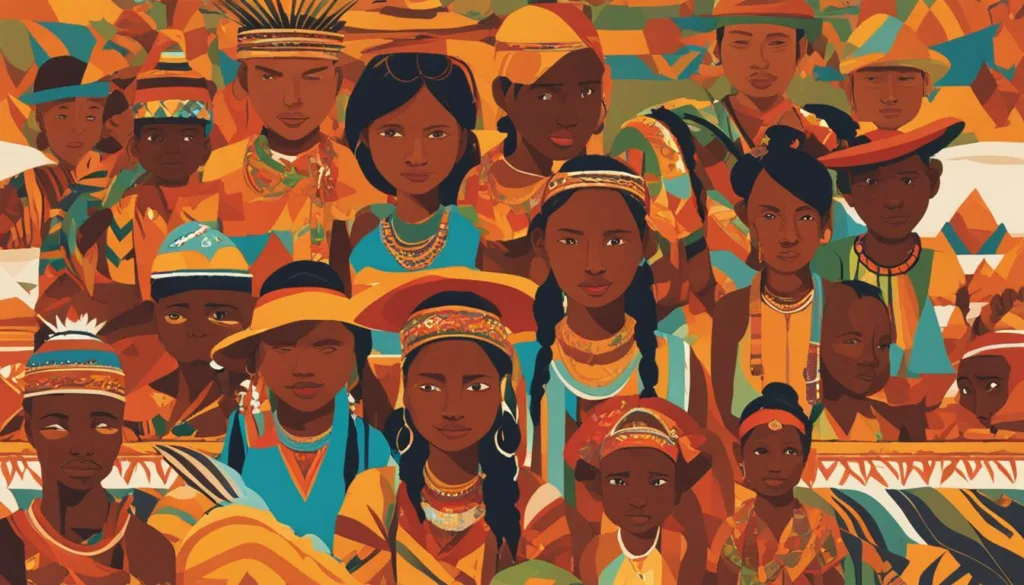
To further appreciate the diverse linguistic environment of Namibia, a comparison of selected Bantu languages and Khoisan languages is highlighted below:
| Bantu Language | Approximate Speaker Population | Khoisan Language | Approximate Speaker Population |
|---|---|---|---|
| Oshiwambo | Over 1 million | Naro | 10,000-20,000 |
| Otjiherero | 200,000-300,000 | ǃXóõ | 4,000 |
| RuKwangali | 80,000-90,000 | Kung-Ekoka | Less than 1,000 |
The table above provides a glimpse into the numerical presence of these languages, emphasizing not only their societal prominence but also the challenges that lie with linguistic minorities in sustaining their language’s usage. The pulse of Namibia indigenous languages beats strong, illustrating the country’s commitment to upholding its linguistic diversity.
The Germanic Influence: German and Afrikaans in Namibia
The cultural and linguistic landscape of Namibia is deeply etched with remnants of its Germanic heritage. Among the diverse tongues that are spoken here, the German language and Afrikaans hold special places in the country’s heart, harkening back to historical times while still remaining vital in contemporary society.
German Language and Namibian Heritage
German, recognized as one of the minority languages in Namibia, continues to be spoken by descendants of early European settlers. The endurance of the German language in Namibia, despite its relatively small number of speakers, is particularly noteworthy. Schools, cultural institutions, and several businesses operate in German, adding to the multifaceted verbal mosaic of the country. Such prevalence underscores the German language’s role in Namibian heritage, where it contributes to the country’s rich historical narrative and tourism appeal.
Afrikaans: A Lingua Franca of Southern Africa
Even more pervasive is Afrikaans, a language that has served as a bridge among various ethnic groups. Its usage extends beyond Namibian borders, reinforcing its stance as a key lingua franca in the Southern African region. This versatile language emerges as a utilitarian medium for day-to-day discourse and is integral to the social fabric of the nation, a true testament to the legacy of cross-cultural integration.
The Germanic imprint on the diction of Namibia goes beyond mere communication. It reflects the intricate interplay between language, culture, and historical context that has shaped the nation’s identity. Namibia’s accommodation and valuing of languages like German and Afrikaans showcase its commitment to embracing the variety within its borders.
Here’s how these languages feature in the spectrum of Namibian dialogue:
| Language | Role in Namibia | Speaker Community |
|---|---|---|
| German | Symbol of historical ties and tourism | Small, but significant minority |
| Afrikaans | Widespread means of interethnic communication | A significant portion of the population |
The retention and reverence of these languages within Namibian society highlight an awareness and respect for the imprints of the past, providing a framework for multicultural cohesion and collective history. As pillars of the nation’s linguistic spectrum, German and Afrikaans not only stand as vestiges of historical influence but also as vibrant, living parts of Namibia’s present.
Namibia’s Linguistic Diversity in Numbers
The vast array of languages spoken in Namibia not only underscores the country’s extensive cultural range but is also crystallized in the statistical breakdown of language demographics. This numerical perspective provides insight into which languages dominate the conversational landscape with a significant plurality of Namibians speaking Oshiwambo, painting a diverse lexical picture reflective of the nation’s ethnic mosaic.
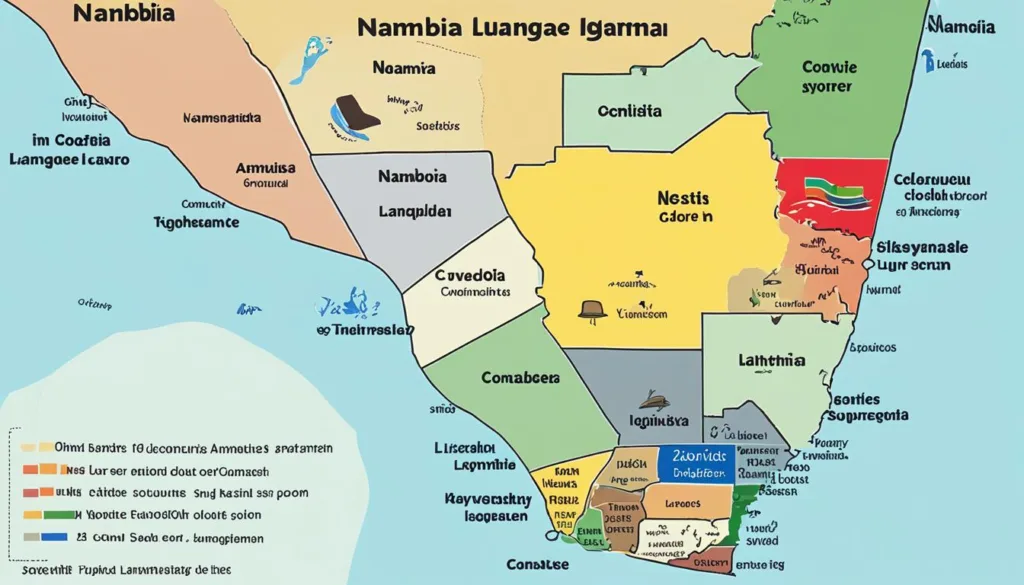
With the Zambezi languages forming a part of the linguistic variety, the interplay among different tongues denotes a dynamic linguistic identity. A quantitative analysis reveals nuances in language preference and usage, indicating sociocultural tendencies and communication trends across Namibia’s communities.
| Language | Percentage | Region Predominantly Spoken |
|---|---|---|
| Oshiwambo | 48.9% | Northern Namibia |
| Khoekhoegowab | 11.3% | Central and Southern Namibia |
| Afrikaans | 10.4% | Nationwide |
| Otjiherero | 8.6% | Central Namibia |
| Zambezi Languages | Undisclosed | Zambezi Region |
The table above encapsulates the linguistic variety of Namibia, from the widely spoken Oshiwambo to the Zambezi languages that contribute to the nation’s unique language demographics. This detailed distribution of languages spoken Namibia provides a clear illustration of how cultural and ethnic diversities are interwoven within the linguistic fabric of the country.
Education and Language Instruction in Namibia
Namibia’s commitment to its cultural heritage is evident in its education system, where a convergence of traditional values and modern educational needs takes center stage. The careful balance of Namibia education principles with linguistic diversity is key for building a country rooted in understanding and progressive thought.
The Medium of Instruction in Namibian Schools
Throughout Namibian schools, the medium of instruction experiences a significant transition as students progress. While local languages play a foundational role in the early years, English becomes the primary language of teaching in secondary education. This strategic language policy aligns with Namibia’s dedication to international connectivity and educational excellence. In practice, the approach opens doors for students, equipping them with both local linguistic roots and global linguistic wings.
Language Inclusion in the Namibian Education System
Language not only shapes communication but also cultural identity and cognition. This philosophy guides the Namibian educational framework, which integrates the teaching of indigenous language syllabus in primary schools, respecting and preserving Namibia’s rich linguistic tapestry. Encouraging the use of indigenous languages in classrooms solidifies children’s cultural foundations, a step viewed as essential for personal and national identity.
| Education Level | Main Language of Instruction | Indigenous Languages Incorporated |
|---|---|---|
| Primary | Local/Indigenous Languages | Oshiwambo, Khoekhoegowab, Damara/Nama, Otjiherero |
| Secondary | English | Monthly cultural studies in various indigenous languages |
| Tertiary | English | Optional courses in indigenous languages and literature |
With the above educational structure, Namibia succeeds in sustaining its multi-lingual legacy while also adapting to the global educational standards. This balanced educational stratagem embodies Namibia’s recognition of the intrinsic value of multilingual proficiency.
Minority and Endangered Languages of Namibia
The intricate mosaic of Namibian linguistic heritage includes a treasure trove of minority languages in Namibia that are at risk of falling into silence. Among them are Kuhane, Mbukushu, and the various endangered languages of the Khoisan group, each with its own cultural significance and history. As the tide of popularity flows towards dominant languages, these minority tongues are grappling with the risk of linguistic erosion.
In the wake of rapid globalization, technological advancement, and urban migration, the speakers of these languages often find themselves in a conundrum between preserving their ancestral dialects and adapting to more widely spoken languages for broader opportunities. Without concerted preservation efforts, we stand to lose more than just words; we risk erasing a vital part of human history and knowledge. Recognizing the vital role these languages play in maintaining the full spectrum of Namibian linguistic heritage is an essential step towards preserving our collective human heritage.
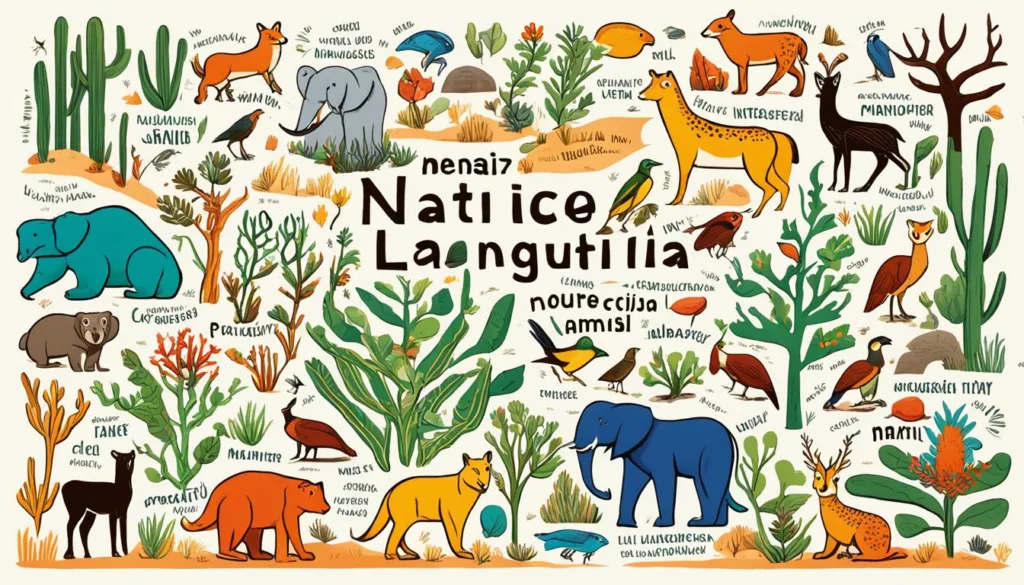
Here are some of the steps being taken to nurture and protect these linguistic gems:
- Language documentation projects that record and study the linguistic features of these languages for academic and preservation purposes.
- Community-driven language revitalization programs that encourage younger generations to learn and use their ancestral languages.
- Inclusion of minority languages in the educational curriculum, making it possible for children to learn these languages in schools.
- Media representation, including radio broadcasts and print media, that give a platform for these languages to be heard and read.
It is imperative for local governments, linguists, and communities to work in unison to reclaim and revitalize these endangered languages, ensuring that the colorful lexicon of Namibia’s histories and stories continues to enrich and inform future generations.
Popular Communication: Namlish and Other Creoles
Namibia’s linguistic landscape is a testament to the nation’s rich history and cultural diversity. In this section, we explore how Namibia’s unique blend of language and culture manifests in popular forms of communication, like Namlish and various creole languages. These communicative forms not only demonstrate the sociolinguistic integration within the country but also add a distinctive element to the global dialogue around linguistic evolution and cultural identity.
Namlish: A Unique Namibian English Variation
Reflected in the everyday vernacular of Namibians, Namlish stands out as a distinct version of English. This colloquial variety of the language incorporates elements from various indigenous language structures and vocabulary, weaving a linguistic tapestry that resonates with a rich Namibian flavor. Namlish illustratively showcases the enduring presence of Namibia’s ancestral heritage even within the framework of a language as globally pervasive as English.
Creole Languages and Societal Integration
In addition to Namlish, the emergence of creole languages in Namibia has been pivotal in fostering societal integration and cultural interchange. These creoles arose from a historical amalgamation of indigenous tribal languages with that of settlers’ and colonizers’, charting a course for a uniquely Namibian way of expression. Below is a table highlighting some notable creole languages in Namibia and their characteristics.
| Creole Language | Origins | Language Family | Common Usage |
|---|---|---|---|
| Kiche Duits | Germanic-African blend | Creole | Sociocultural communication |
| Baster Afrikaans | Afrikaans-Khoisan blend | Creole | Community-specific dialect |
| Nama-Damara Pidgin | Khoekhoegowab – Other local languages | Creole/Pidgin | Inter-ethnic communication |
The integration of these creole languages into the Namibian society is a vibrant example of how language adapts and evolves to meet the sociocultural needs of its speakers. They play a critical role in maintaining the linguistic diversity of Namibia and enhancing the sociolinguistic integration across various ethnicities, converging to form a wholesome linguistic identity.
Conclusion
The vibrant nation of Namibia is a testament to the resplendence and intricacy of human language. Its vast linguistic landscape is a tapestry as elaborate and expansive as the country’s legendary dunes and rich cultural tapestry. With an array of languages spoken throughout Namibia, each dialect contributes a unique thread to the nation’s socio-cultural fabric. English stands as the official language, a beacon guiding Namibia on its course to international integration and development. However, this is just a part of the story.
Beyond English, the indigenous languages and dialects of Namibia—from the widely spoken Oshiwambo to the intriguing Khoisan click languages—embody a deep connection to the land and its past. These languages are not merely a means of communication; they are the bearers of Namibia’s linguistic heritage, steeped in history, tradition, and identity. The safeguarding and promotion of these languages are vital not only for preserving the unique cultural legacy of the nation but also as a foundation for educational enrichment and inclusive dialogue within communities.
As we have seen, the Namibian dialects coexist with a mutual respect and harmony that bolsters the national identity and unity. This coalescence is a celebration of Namibia’s diversity, reinforcing the importance of every voice, no matter how small or large its number of speakers. The languages spoken in Namibia are more than a mere means of expression—they are the soul of the nation, markers of a shared heritage and a promise for an inclusive, multidimensional future. It is this collective linguistic treasure that makes Namibia an exemplar of cultural coalescence and linguistic diversity.
FAQ
What Languages are Spoken in Namibia?
Namibia is a vibrant nation with multiple languages including Oshiwambo dialects, Khoekhoegowab, Afrikaans, RuKwangali, Otjiherero, German, and the lingua franca, English. It also features indigenous languages, minority dialects, and a unique blend of English called Namlish.
What is the Official Language of Namibia?
English is the official language of Namibia, adopted after independence to unite the country and to facilitate international relations.
How Have the Languages Spoken in Namibia Changed Over Time?
Prior to independence, Afrikaans and German had official status along with English. After independence in 1990, English became the sole official language. Despite this, indigenous languages have continued to hold cultural significance and are widely spoken.
Which Languages are Most Commonly Spoken in Namibia?
The most spoken language is Oshiwambo, used by nearly half of the population, followed by Khoekhoegowab and Afrikaans. English, owing to its official status, is also widely spoken and understood.
Can You Tell Me About the Bantu Languages in Namibia?
Bantu languages in Namibia include Oshiwambo, Otjiherero, and RuKwangali, Setswana, Gciriku, Fwe, Kuhane, Mbukushu, and Yeyi, among others, reflecting the diverse ethnic makeup of the country.
What Khoisan Languages are Spoken in Namibia?
Khoisan languages, known for their distinctive click consonants, such as Nama, Damara, Naro, ǃXóõ, and Kung-Ekoka, are part of the rich linguistic heritage of Namibia.
What Role Does the German Language Play in Namibia’s Heritage?
The German language, spoken by a small minority, is a remnant of Namibia’s colonial past and the German settler influence. German is still used in Namibian businesses, tourism, and cultural events reflecting its historical significance.
How Important is Afrikaans in Namibia?
Afrikaans is an important lingua franca in Namibia and Southern Africa. Spoken by a significant portion of the population, it acts as a bridge for interethnic communication.
What Are Some Minority and Endangered Languages in Namibia?
Languages such as Fwe, Kuhane, Mbukushu, and the various Khoisan languages are considered minority or endangered. They are part of the rich linguistic tapestry of Namibia but require active preservation efforts.
How are Languages Integrated into Namibia’s Education System?
Indigenous languages are part of the primary school syllabus with English as the medium of instruction from secondary education upwards. This reflects Namibia’s commitment to cultural preservation while promoting proficiency in English for global communication.
What is Namlish?
Namlish is a colloquial form of English unique to Namibia, incorporating elements and structures from indigenous languages, showcasing the country’s creative linguistic amalgamation.
Are There Creole Languages Spoken in Namibia?
Yes, creole languages have emerged from the interaction of the diverse cultural groups present in Namibia, adding to the nation’s sociolinguistic integration and identity.
